
Support Team
Feedback:
support@nextpcb.comPCB usage and designing of them started in the 20th century and now it is the heart of modern industries. One of the main steps that undergo in PCBs is wire bonding. Wire bonding undergoes two different methods, and the usage of the other techniques may depend upon the application.
In simple terms, wire bonding is the interconnecting of the internal parts of the chips to the outside of the chip. Statically it's a fact that a 4 trillion wire bonding process happens per year.
Semiconductor manufacturers use Wire Bonding as a technique to connect the integrated circuits to the electrical appliances. Wire bonding is the best option to use when combining a few more integrated circuits or when connecting a few PCBs (Printed Circuit Boards).
Importantly when considering the cost and the durability the wire bonding is at the top of making interconnections. Considering the cost and the other advantages, now wire bonding is a common technology in the industry. If we consider more deeply about wire bonding, it is a welding method that uses different techniques to fix the metal wires to the chips.
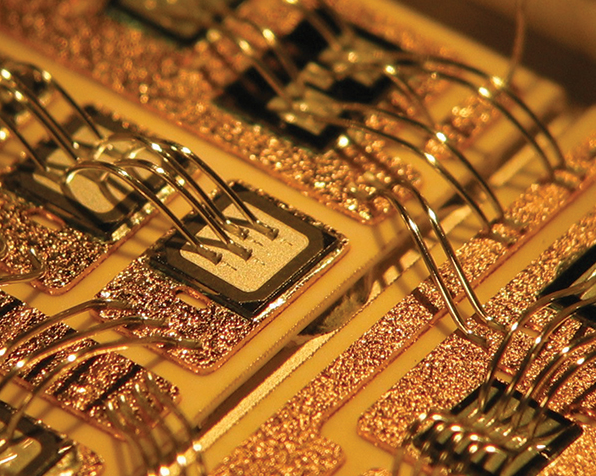
Connecting the bonds between PCBs to PCBs and in-between semiconductor chips to the wires is not an easy task to carry out. Therefore this wire bonding process is highly technological. The hardest thing that is in here is making durable and precise connections. So, every connection should be highly accurate as can be. A huge impact on the economy of the industries could happen if these connections are not feasible and accurate. Manufacturers always consider developing a durable and accurate process for wire bonding.
The most current techniques for attaching wires to silicon semiconductor systems that are affordably delivered featured tiny solder balls that typically bonded the chip surface to the wire. The reliability of the solder bonding was shown to be poor. In a few instances, the joint had a poor mechanical bond. On the other hand, the solder bonding might cause a semiconductor material to cross with a diode. So that would reduce the semiconductor's performance.
We can find wire bonding in most of the appliances that we used in our day-to-day life. They are mobile phones, laptops, and other high-end technological equipment such as microcomputers and microcontrollers. Most of these devices use wire bonding within their PCBs because it makes sure about the durability and functionality of the components.
When considering mobile phones the wire bonding can be found in the battery of the mobile phones. In the field of mobile phones, we can consider wire bonding as wire bonding is a technology that uses ultra-sonic, metal-metal friction methods for the welding of the battery cells to make a battery pack. In the early stages of industries like mobile phones, manufacturers were using spot welding to make such kinds of connections between terminals. But with the rising of wire bonding technology, it replaced spot welding.
When considering the manual spot welding for the mobile phone battery packs and other chips, short circuits and issues in the batteries came up. The reason behind that is due to the high-temperature gain at the spot-welding affecting negatively on the battery lifespan and, the loose connections are also a problem that arises in the spot-welding process. Due to the spot-welding loose connections will damage the BMS (Battery Management System).
Using the wire bonding technique replaced the spot welding technique from most industries.
There are now a few different ways to connect cylindrical cells to the busbar. The more popular connecting techniques are wire bonding, laser welding, spot welding, resistance welding, and spot welding. Ultrasonic energy is used in wire bonding to cause the wire or ribbon to share electrons with the surface, forming an atomic bond. As the ultrasonic procedure eliminates the oxide layer and exposes virgin aluminum to allow the transfer of valence electrons, the self-limiting aluminum oxide aids in optimizing the wire bonding process.
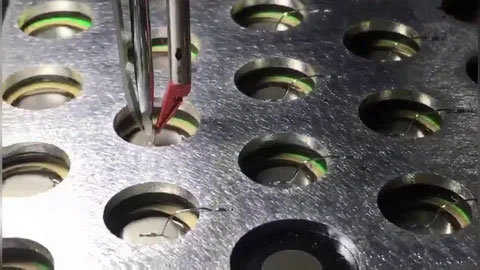
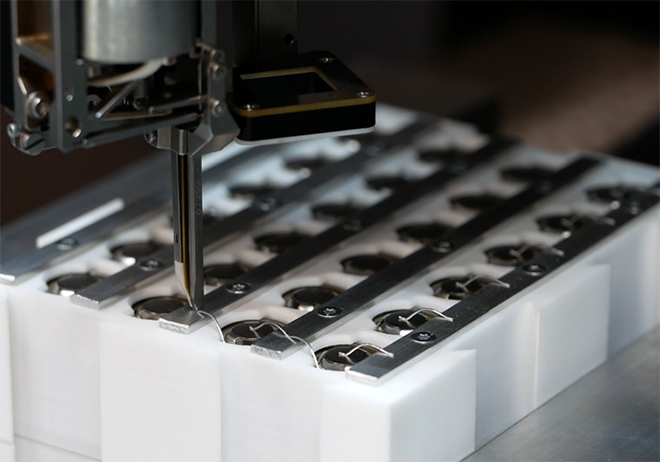
Microcomputers are a type of small computers that can perform different functions according to the user requirements. In microcontrollers also, the manufacturers are using wire bonding. This will make the terminal communication more precise and durable for better performance of the microcomputer. The type of material used for the wire bonding of the microcomputers also affects the performance of the microcontroller. As the signals are the main thing in the microcomputers that use for functioning.
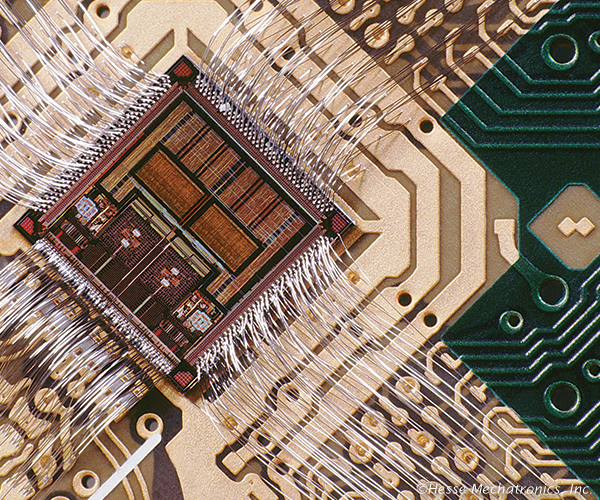
when considering the wire bonding with the developing PCB industry, it can be seen that most industries are moving towards high-sensitive PCB manufacturing. So wire bonding is a special case that is common to the PCB industry.
There are reasons why manufacturers should use wire bonding other than stick to old traditional methods. Some of the reasons are as follows:
Considering the above cases, it's evident that the primary reason for using this method is its anti-corrosive properties and the long-term stability of the connections. The wire bonding approach also offers many advantages over other previous techniques. In the context of electric vehicle (EV) technology, wire bonding provides low resistance and robust connections for battery packs, ensuring a continuous power supply from the battery packs.
The main purpose of wire bonding is to make connections between chips and other connectors. In that case, the reliability and durability of the connection are highly concerned. Encountering all the above-mentioned factors in a profitable ammer is another advantage in wire bonding. Most importantly the wire bonding can apply over the PCBs handling a frequency above GHz. It has been an essential factor to consider. They are the signals and voltage pulses when comes to the modern technological world.
That's because now everything in the technological world is using electronic voltage signals. Moreover, the computational parts of modern appliances need real-time communication between other parts. So in order to supply, reliable communication between them reliable and durable communication path is essential. Furthermore, the speed of transferring data between the electronic modules is another factor that PCB manufacturers should consider. So in order to supply speedy communication, wire bonding is the best option according to the newest technologies. It helps to minimize the distortion that can happen to the signals.
For that wire, bonding came as a solution that has the ability to cover all mentioned important factors.
Moreover, when considering today's main topic EV, manufacturing companies always keep their attention on the following factors. Mainly if they undergoing the wire bonding technology.
The capacity to conduct an in-situ mechanical pull test is provided by wire bonding. In the non-destructive test, a force applies to the bond and evaluates the strength of the bond. This applies for is a pre-set value force. Pull testing can identify weak or non-stick bond failures that cause newborn death. Pull test findings are instantly accessible and can make a database for complete traceability, much like the bond process data.
Stress relief loops between the connecting points use to tolerate thermal strains from the environment and from the product itself. Wire connecting technologies develops for wire diameters ranging from 18 microns on the low side to 600 microns on the high side. To meet the criteria for resistance and conductivity, suitable wire diameters can use. The loop form can dynamically adjust to changes in bond sites for required resistivity or impedance matching.
This is occasionally necessary for electronics operations for fine-tuning accurate resistivity or impedance. Due to their greater cross sections, ribbon bonding methods use to permit higher current transfer, and they design to cover a wide range of sizes.
Several electrical and mechanical signals are recorded in real time while the wire bonding operation is taking place. This enables quick checking of the bond terms and a determination of bond quality while the bond transaction is ongoing. Modern data analysis methods allow for the classification and matching of the signs of typical failure mechanisms. Such as contamination or wrong bonds, as well as the storage of suspect bonds for further post-bond examination.
The possibility to replace weak or unsuccessful wires on a per-wire basis and try rework is provided by wire bonding. When compared to other connection methods, which only provide a single chance of success, the option to redo offers a special advantage.
Above are some special points that consider when wire bonding is taking place. In the industry and it is clear that wire bonding is more advantageous.
Most industries use Wire Bonding under three main methods. They are as follows,
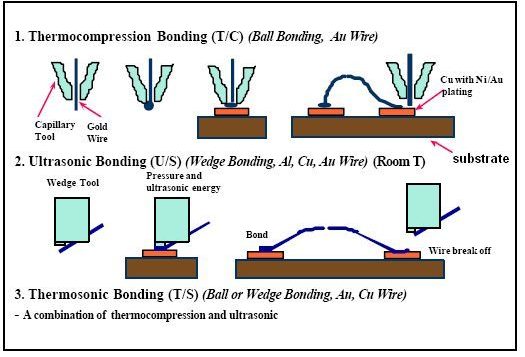
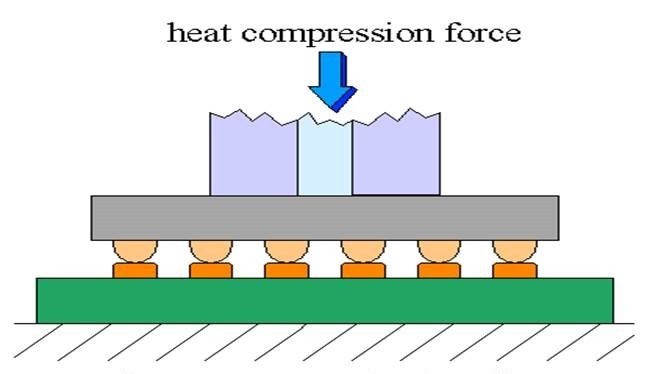
A solid phase direct bonding procedure without an intermediary layer is thermo-compression bonding. The principal use of materials like Cu, Au, Al, and Ti is to improve one or both bond partners. Atomic contact, temperature impact, and pressure all contribute to the bond-forming process. A fascinating approach for obtaining wafer-level bonding at low temperatures without the use of an electric field (anodic bonding) or a laborious pre-bond cleaning step is thermo-compression bonding of metals (plasma-assisted silicon direct bonding). Due to electronics considerations, the usage of metals like Al and Cu are at the top of the priority, particularly for 3D integration.
Both the sealing and the electrical connection may be accomplished during one bonding procedure. Although the thermo-compression bonding of gold and copper has been known for a while, we are also using Al-based bonding. Contrary to the Au and Cu-based bonding, the Al thermo-compression bonding is of great interest. Since it can be implemented extremely quickly, even in CMOS processes.
Advantages of the thermo-compression bonding process:
A procedure that joins two materials by applying pressure, time, heat, and ultrasonics. To form the connection, the wire is sometimes subjected to heat before being lightly rubbed against a hot surface (at 150 degrees Celsius or less).
This procedure makes use of gold wire and a gold bond surface, and it was first connected to Ball Bonding because Ball Bonding was the first application of ultrasonics as a bonding parameter. Even though the term "Thermosonic Bonding" is now used to describe wedge bonding, there are still some people who will only use it to refer to ball bonding.
Copper wire is using for this procedure in recent years, but the equipment needs modifications in order to stop the oxidation of the wire and, in particular, the ball during its production during flame-off.
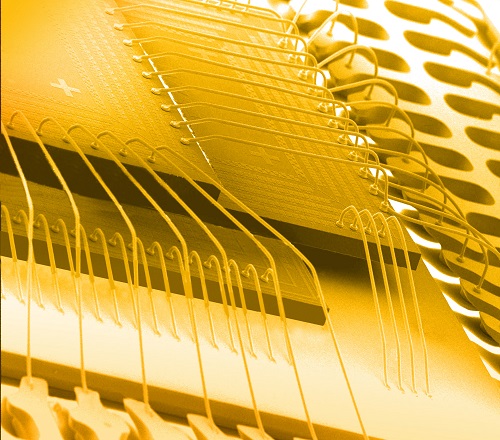
Gold Wire bonding is the process of attaching a gold wire to two places in an assembly. To create an electrically conductive channel or connector. The attachment points for the gold wire form using a combination of force, heat, and ultrasonics.
The production of a gold ball at the capillary, the tip of the wire bond instrument, marks the beginning of the attachment point creation process. The tool used to press this ball against the heated assembly surface while also generating ultrasonic motion at a frequency between 60 kHz and 152 kHz.
After the initial bond is complete, the wire will be carefully maneuvered to create the proper loop shape for the assembly's geometry. The second bond, also known as the stitch, is then created on the opposite surface by applying pressure with the wire and tearing it at the bond with a clamp.
When compared to some solders, gold wire bonding provides a connectivity method within packages that are approximately an order of magnitude more electrically conductive. Gold wires are also softer than most and have a higher oxidation tolerance than other wire materials, which is crucial for delicate surfaces.
Depending on the requirements of the assembly, the procedure may also change. A gold ball uses on the second bonding area when working with delicate materials to forge a stronger and "softer" bond that won't scratch the component's surface. A single ball can serve as the beginning point for two bonds in confined settings, generating a "V"-shaped bond. A ball sets on top of a stitch to produce a security bond, enhancing the stability and strength of the wire when a bond between two pieces of wire has to be more robust. Utilizing software on Palomar's wire bond systems, the practically infinite number of applications and variations for wire bonding is possible to carry out.
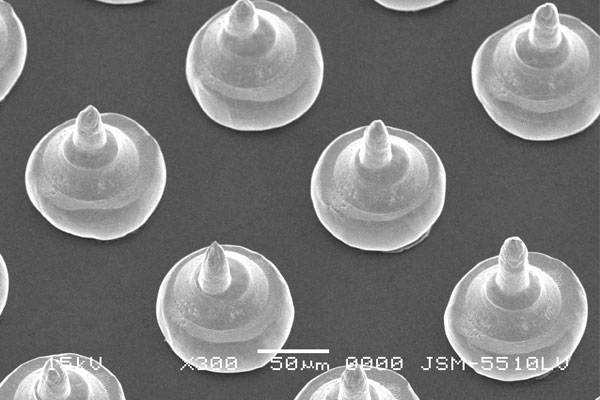
In flip-chip applications, ball bumping is crucial because it creates crucial interconnects between the chip and substrate. Ball bumping is possible on a wafer or an assembly level, however, it typically carries out on a wafer level.
In that, a ball creates at the capillary and gets deposited onto the surface using a combination of force, ultrasonics, and heat, ball bumping is very similar to the initial step of gold wire bonding. The wire will shear off immediately above the ball, creating a planar bump on the part's surface, as opposed to forming a loop after the ball attaches.
The overall size of the bump is controlled by controlling the ball size, which depends on a trustworthy bonding procedure to maintain a constant wire tail length prior to ball formation. There will be considerable differences in bump sizing if each bump is not regularly executed effectively.
The precise application of force is important in the bumping process since it affects the bump's height and shape. In order to create bumps with a consistent size and planarity, the shearing procedure is using to separate the wire from the ball must be precisely checkout.
It is essential for the assembly procedures that will use these components, later on, to form consistent planar bumps all across a wafer.
The advanced software program "Tailless Smooth Bump" from Palomar offers all the essential settings for producing bumps. It has remarkably constant in size, shape, and planarity for this process. The most effective solution for any ball-bumping application is provided by this software. In conjunction with the dependability and competence of the 8000i wire bonder.
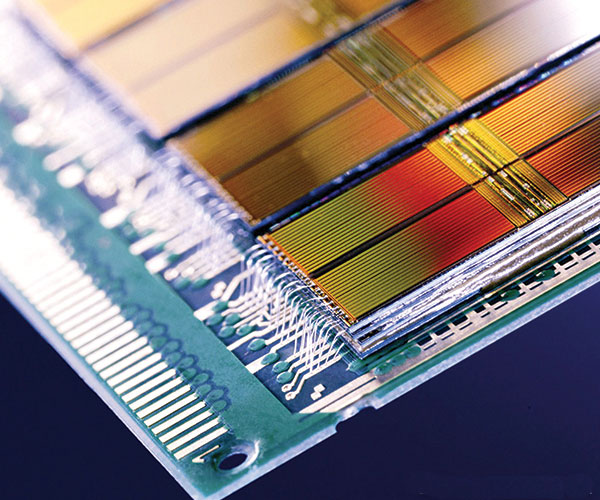
Without using a ball for the first bond, wedge bonding forms the stitches on both ends using a wedge tool. The connections themselves are narrow and oblong. Both gold and aluminum wire is the best options for wedge bonding, however, aluminum wire at room temperature is more typical.
A ribbon or circular wire is possible to use for bonding during the wedge bonding procedure. The capillary on a ball bonder must be oriented in the direction of the bond, but the wedge bonding tool can rotate to bond from any angle. This enables bonding for a certain assembly from all possible angles.
The ultrasonic bonding procedure is rising since the 1940s and has had time to develop in a range of sectors. It was initially created for metal welding; however, it was later modified for plastic parts. The thickness of the components that need to be linked determines whether the ultrasonic welding technique is feasible. Thick pieces can typically not be bonded together using ultrasound. The machinery and combined materials will determine the maximum thickness, which is normally a few millimeters. Applications for ultrasonic metal welding are only for malleable metals like nickel, copper, and aluminum. The method widely uses for bond sheet metal, microcircuit connections, foils, ribbons, and meshes.
Ultrasonic bonding needs a spotlessly clean surface free of debris, grease, and other impurities. Corrosion or bond failure might happen if the surface has a small number of polluted particles.
In the case of batteries, to avoid the damages that can happen to the internal parts, cleaning of the batteries should carry out more safely. Therefore, abrasion-producing mechanical techniques are very harmful to use.
Some manufacturers manually prepare surfaces by wiping them down with clean cloths, isopropanol, and acetone. Although they can get fantastic results, this technique is not practical for manufacturers who wish to speed up and optimize their processes. The only method that now perfectly cleans small, localized surfaces while enabling automation is laser cleaning.
The ultrasonic bonding method is common in the industries such as the computer and electrical industry, Aerospace and automotive industry, and mostly in the medical industry.
A crucial technology for the assembly of battery module components is ultrasonic wire bonding. To distribute the current, cells connect to busbars (or current collectors) through wires. In most cases, they are on the top of the module.
| Wire Bonding | Operating Temperature | Wire Material | Pad Material | Note |
|---|---|---|---|---|
| Thermocompression | 300-500℃ Au | Au | Al, Au | High pressure, no ultrasonic energy |
| Ultrasonic | 25℃ | Au, Al | Au, Al | Low pressure in ultrasonic energy |
| Thermosonic | 100-240℃ | Au, Cu | Al, Au | Low pressure in ultrasonic energy |
Gold is the chosen material for bonding wire due to its many advantages. High electrical conductivity, superior corrosion resistance, and the capacity to get bonds in place in an ambient environment are some of these advantages. The most widely used metal for bonding wire is still gold, which is carefully purified to high purity (99.99 percent gold).
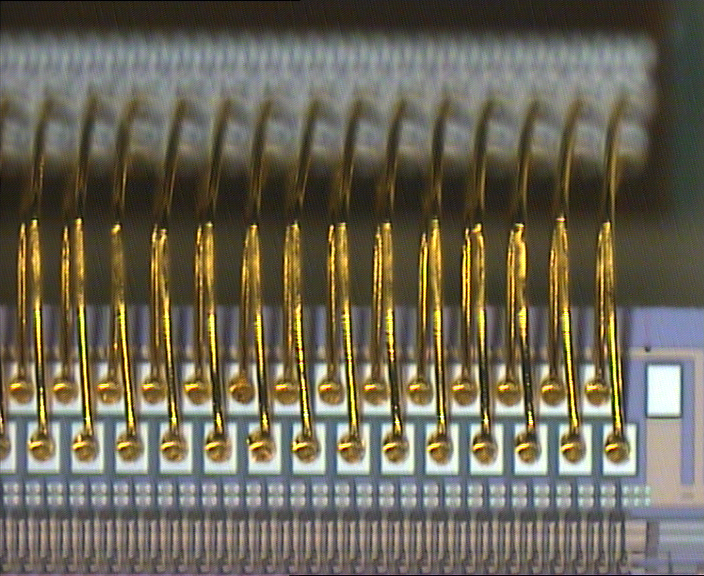
Ball bonds and wedge bonds are the two basic types of wire bonds. Gold wire is quite versatile and can weld to either a ball or a wedge. Below is a description of how to make a gold wire bond.
In the electronics industry, there are multiple competing needs for cost reduction, smaller components, and greater system functionality. In the near future, insulated wire bonding technology will employ to assist chip manufacturers and designers in balancing these conflicting objectives. By adding insulation to bare gold bonding wires, short circuits get control, making it possible to realize chip designs that were previously impractical.
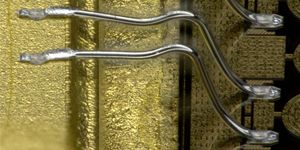
A crucial distinction between aluminum wire bonding and gold wire bonding is that the surface does not need to be heated to 150°C or even just slightly above ambient temperature. Aluminum bonds are formed with the help of force and ultrasonics. The process for making an aluminum wire bond, which includes two attachment places and a particular loop shape, is the same as for making a gold wire bond. Since the surface does not need to be heated during the attachment steps for the wire, the only elements required for the binding are force and ultrasonics.
Similar to gold wire, aluminum wire offers a reliable electrical conduit for connections between parts of an assembly, but it also has certain important advantages. Aluminum bonding enables the formation of interconnections on assemblies. The bondings are temperature-sensitive and the materials are unable to tolerate the temperatures typically needed for gold bonding. On aluminum surfaces in hermetically sealed containers, aluminum wire is also much more favored over gold wire because the temperatures required for hermetically sealing might weaken the links between aluminum and gold.
Wedge bonders frequently use aluminum wire, which, along with gold wire, represents the two primary material kinds for wire bonding. Due to their distinct qualities, other materials, including certain alloys, employ in some particular wire bond applications. Successful wire bonding depends on the ability to use the right frequency, force, and temperature for any specific material. The wire bond systems at Palomar have it fully incorporated.
Because of their affordability and resistance to sweep (the tendency of the wire to move in the plane perpendicular to its length) during plastic encapsulation, copper-ball bonding to IC metallization has recently attracted a lot of attention. The bondability of this system is its main flaw. Because copper is tougher than gold and aluminum, metallization may happen or will push away. Consequently, a tougher metallization is needed. Additionally, because copper oxidizes easily, the ball bonding procedure must be done in an inert environment.
Wire bond manufacture and reliability face a number of difficulties. These difficulties frequently depend on a number of variables, including the material systems, bonding parameters, and use environment. Aluminum-Aluminum (Al-Al), Gold-Aluminum (Au-Al), and Copper-Aluminum (Cu-Al) are three separate wire bond-bond pad metal systems that need various production conditions and perform differently in the same application settings.
Numerous studies are undergoing to evaluate different metal systems, examine important manufacturing parameters, and pinpoint common reliability problems that arise in wire bonding. The application and usage environment will determine the metal system when it comes to material choice. When selecting a choice, the electrical, mechanical, and financial aspects are frequently under the consideration.
For example, a large-diameter aluminum wire bond in a hermetically sealed ceramic box would be necessary for a high-current device for space application. Avoiding gold wire bonds may be necessary if cost is a major restriction. Studies on copper wire bonding in automotive applications currently undergoing. This is only a small sample of extensive research. That did for examing and testing which material systems perform best in various applications.
The bonding parameters are crucial for bond formation and bond quality from a production standpoint. Bond quality can significantly get impacted by a number of variables. They are bond force, ultrasonic energy, temperature, and loop shape, to mention a few. Different wire bonding methods (thermosonic, ultrasonic, and thermocompression) and wire bond types (ball, wedge) have an impact on how susceptible they are to manufacturing flaws and reliability problems. For fine pitch or a complicated design, specific materials and wire sizes are more useful. The stack-up of the barrier layer and metallization will have an impact on the bond formation. Hence the bond pad is also crucial.
Poor bond quality and manufacturing flaws commonly cause failure modes. They are fractures at the ball bond neck, heel cracking (wedge bonds), pad liftoff, pad peel, overcompression, and inappropriate intermetallic formation. To identify manufacturing and quality problems, a combination of destructive physical analysis (DPA), nondestructive testing, and wire bond pull/shear testing can use as tests.
Wirebond manufacturers frequently ignore wear-out factors that affect wire bond reliability while concentrating on bond quality. In this situation, knowledge of the application and usage environment can assist in avoiding dependability problems. Elevated temperature, high humidity, and temperature cycling are a few examples of situations that frequently cause wire bond failures.
Excessive intermetallics (IMC) development at high temperatures can lead to brittle areas of fracture. There has been a lot of research done to describe intermetallic development and aging for different metal systems. This is not an issue in metal systems where the wire bond and bond pad are made of the same material as Al-Al. In systems made of different metals, this does become an issue. The brittle intermetallics generated in gold-aluminum IMCs, such as purple plague, are one of the best-known examples. Wire bond failures can cause by diffusion-related problems like Kirkendall voiding and Horsting voiding.
Corrosion can be a problem in areas with high humidity and temperature. Galvanic corrosion is what causes this, which is most prevalent in Au-Al metal systems. Halides like chlorine can speed up this behavior when they are present. When describing this Au-Al corrosion, Peck's law for temperature and humidity also take into consideration frequently. Other metal systems do not use this as frequently.
Due to a mismatch in the coefficient of thermal expansion (CTE) between the epoxy molding compound (EMC), the lead frame, the die, the die adhesive, and the wire bond under temperature cycling, thermomechanical stress will generate in the wire bond. Because of the shear or tensile strains in the wire bond, this causes low cycle fatigue. The fatigue life of wire bonds under such circumstances can predict using a variety of fatigue models.
Having a thorough understanding of metal systems and the usage environment is frequently the most crucial aspect of raising wire bond reliability.
Although there are various wire bond pull and shear testing methods, these are more frequently used to assess the manufacturing quality of products than their reliability. They frequently involve monotonic overstress techniques, where the essential results are the peak force and fracture location. The damage in this instance cause due plasticity and does not reflect any wear-out mechanisms that may be visible in an environmental setting.
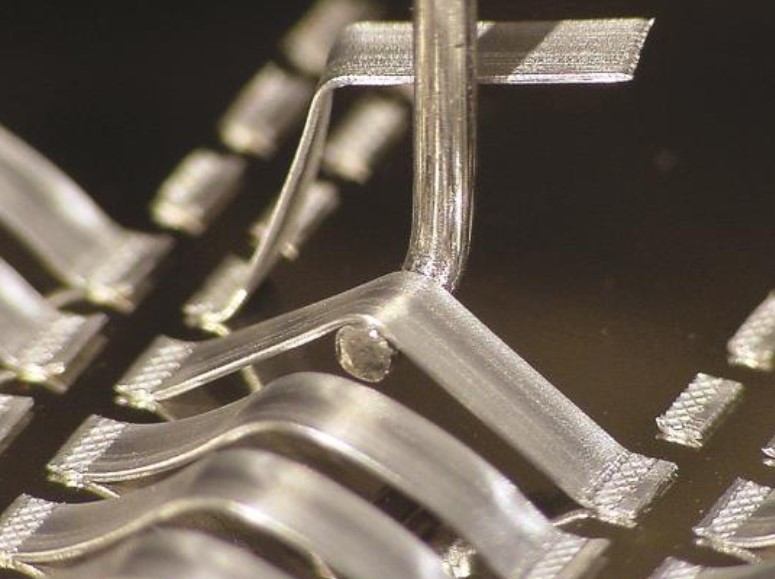
It entails employing a metal hook to draw a wire up in the z-axis. A specific force applies to the bond during a non-destructive test, or the force can increase during a destructive test until the bond or wire breaks. The results of the analysis used to assess bond strength result in a number of failure modes during the test. A crucial component of the test is the test parameters, such as test speed and tool location, as variations in these factors might result in a variety of failure mechanisms.
It is possible to do the Ribbon bonding using the wire pull testing. It is standard procedure to pull the wire's center during wire pull tests. It's can identify as the mid-span pull. Alternately, if the bond is tested at one of the ends, the hook can be positioned close to that end if that is the failure mode of interest. It's crucial to pull the wires at the same position for comparison when testing numerous samples.
Along its length, the wire snaps in the middle. Since the bonds on both ends of the wire are still strong, this result does not represent the bond strength. If the bond's actual load is likely to be similar to the force needed to break it, the outcome might be acceptable.
The portion of a wire that is closest to the ball is known as the heat-affected zone (HAZ). Although heat is applied, HAZ's microstructure is disrupted instead of melting. The heat-affected zone (HAZ) is the weakest link in a wire bond, as demonstrated by the pull test in which the wire breaks from the HAZ.
The wire breaks at the loop's heel, indicating that this area of the bond is the weakest. The heel strength is the focus of the test; if it is deemed unacceptable, bonding parameters like the bond head force and loop shape may be changed.
Due to faulty intermetallic connections, the bond can separate from the neck or heel. This test demonstrates the bond's strength, which may or may not satisfy the criteria of the application.
A bond pad on the substrate or packaging may lift off the bond during a pull test. This demonstrates how much stronger the bond is than the bond pad.
It entails exerting pressure on the ball bond to move it laterally. The strength of the ball bond is the force responsible for the ball's lateral movement. The two main shear test factors are test speed, which represents how quickly the bond is loaded, and shear height, which is the height at which the ball is pushed by the tool.
The bond failure is the most significant failure that the test can produce, while there are other interesting failure modes as well. A bond can typically get weaker due to subpar material quality, bondage, and improper bonding techniques. Gold and copper balls, solder bumps, and copper pillars can all test with shear testing.
Most of the time peel testing is the best testing method for Ribbon connections. To draw the ribbon up, pull it up in the z-axis while holding one end of the ribbon or wire with tweezers. A force vs. displacement graph created by the peel test shows the strength of the ribbon connectors. A flexible choice for evaluating ribbons is the peel test, which can accommodate a wide range of ribbon sizes and loop topologies.
A wire-bonded die assembly is heated to a certain temperature or subjected to thermal cycling as part of thermal testing. The goal is to subject the wire bond to thermal testing to see whether it can withstand application requirements. Electronics applications or fabrication procedures like curing an encapsulation might result in thermal stress.
To identify any potential problems with the wire bonds, such as bond break due to metallization lift-off, structural deformity of the ball bond or bump, soft metallization, poor heel stick, and heel cracks. In addition to the standard wire bond tests, the wire bond structures can observe using SEM or the optical profiler. The visual examination is possible to use in conjunction with the wire bonder to spot recurring problems that weaken the bond strength and fix them.
Wire bonding serves as a means of introducing and removing electrical connections from the main components. There are three types of wire bonding technologies in the industry. They are Hot pressing wire bonding (TC), wedge-wedge ultrasonic wire bonding (US), and heat ultrasonic wire bonding. They are common technologies in the industry.
Above list is the main advantage that we can gain from wire bonding. When referring to wire bonding it is clear that this technology is popular in the domain of microelectronics. The reason behind that is, the wire bonding will give the best quality high effective signal-passing ability to the electronics. After coming through many technologies, in the end, wire bonding came up as the solution. Moreover, wire bonding is mainly using elements such as Aluminum, Gold, and Copper. When considering the usage percentage most industries are using gold for wire bonding. The properties of gold are the main reason for its high usage in the industry.
However, other materials, such as aluminum, copper (Cu), or combinations of such materials (gold wire on aluminum metallization or copper wire on silver metallization), utilize depending on the technique and applications. The most popular method of wire bonding is called ball bonding, which combines thermal energy and ultrasonic vibration with conventional bonding stress. The method requires heat between 100 and 250 °C. However, the evolution of the wire bonding process led to the creation of this technology. By accelerating the procedure and using lower temperatures, adding ultrasonic vibration to the standard bonding load has enhanced the quality of joining.
most industries tend to use this technology because it gives better communication and mainly space reduction. So when considering robotics applications, sensor developments, and medical equipment development the size of the equipment should be a factor that the developer should consider. Because of that PCB industries are always looking forward to minimizing the size of their chips and other electronic components. When considering medical equipment with cameras such as a laryngoscope use this wire bonding technology to minimize space usage.
Wire bonding directly between Integrated Circuits should avoid unless performance demands it. Stitching will transfer mechanical energy to the pad surface, which could lead to breaking beneath or within the pad metallization. Because cracks can indicate a potential reliability problem, the substrate should construct with intermediate bonding pads.
Bond wires shouldn't cross over between another die, wire, or bond pads. The wire bond unsupported loop may hang and meet or contact a wire directly beneath it if mechanical stress from an external source is applied, resulting in a short circuit that might harm the entire system.
The bond pad should be set up to create the shortest wire bond feasible. The overall impedance, inductance, and connection capacitance are all specified by the wire bond length. Long wire bonds might not perform well for a package. Flash gold with aluminum or gold wedge bonding is a particular scenario. Even so, it would be wise to review the integrated circuit package's implementation notes because some integrated circuit manufacturers do not use wedge bonding due to the mechanical force needed to cause die during production.
A via should have a space from the edge of a bond pad by at least 0.005 mm. A connection that has been created close to a substrate discontinuity may lead to material injury from bonding and distributing mechanical energy to the substrate. To allow for wire bonding tolerance, registration, and printing when wire bonding multilayer substrates, the used pad should be at least 10 mm away from the conductor edge.
Still, need help? Contact Us: support@nextpcb.com
Need a PCB or PCBA quote? Quote now